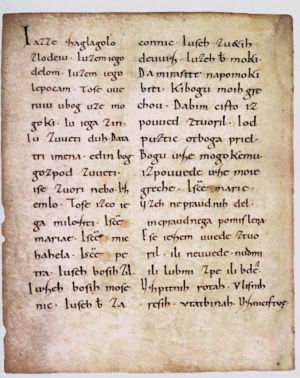- Freising Manuscripts
-
The Freising Manuscripts (also Freising Folia, Freising Fragments, or Freising Monuments; Slovene Brižinski spomeniki, Latin Monumenta Frisingensia) are the first Latin-script continuous text in a Slavic language and the oldest document in Slovene.
The monuments consisting of three texts in the oldest Slovene dialect were discovered bound into a Latin codex (manuscript book) in Freising, Bavaria. The Slovene name Brižinski spomeniki, literary meaning "The Brižinj Monuments", was coined by the Carinthian Slovene philologist Anton Janežič who Slovenized the German name Freising to Brižinj. In 1803 the manuscript came to the Bavarian State Library in Munich and the Freising Manuscripts were discovered there in 1807.
Four parchment leaves and a further quarter of a page have been preserved. Linguistic, stylistic and contextual analyses reveal that these are church texts of careful composition and literary form.
The precise date of the origin of the Freising Manuscripts cannot be exactly determined; the original text was probably written in the 9th century. In this liturgic and homiletic manuscript, three Slovene records were found and this miscellany was probably an episcopal manual (pontificals). The Freising Manuscripts in it were created between 972 and 1039, most likely before 1000. The main support for this dating is the writing, which was used in the centuries after Charlemagne and is named Carolingian minuscule.
During the time of the writing of the two manuscripts (sermons on sin and repentance, a confessional form), Bishop Abraham was active (from 957 to 994) in Freising. It is believed that the manuscripts were written in the Möll River Valley in Carinthia. For this reason some linguists (e.g. Jernej Kopitar and Rajko Nahtigal) linked Abraham closely to the origin of the Freising Manuscripts and, without any firm evidence,[citation needed] attributed to him the authorship of one of the texts and suspected that he was of Slovene origin.[citation needed] The texts were translated into modern Slovene in 1854 by the philologist Anton Janežič.
The manuscripts are still kept at the Bavarian State Library in Munich and have left it only twice. In the 1970s they were exhibited in Vatican City and in May and June 2004 they were exhibited at the National and University Library in Ljubljana.[citation needed]
Before the Second World War a facsimile of the Freising Manuscripts was published by Silvester Škerl at Akademska založba in Ljubljana.
Contents
See also
References
Sources
- Brižinski spomeniki - Monumenta Frisingensia. Elektronska znanstvenokritična izdaja, ZRC SAZU, Ljubljana 2007 (includes facsimiles, several transcriptions, audio recordings, parallel views, translations, English and German summary, glossary, bibliography, etc.)
- Brižinski spomeniki - Monumenta Frisingensia (Znanstvenokritična izdaja), ZRC SAZU, Inštitut za slovensko literaturo in literarne vede 2004
- A. V. Isačenko, Jazyk a pôvod frizinských pamiatok (The language and origin of the Freising manuscripts), Bratislava 1943
- http://kodeks.uni-bamberg.de/AltSloven/Quellen/ASL.Freising.htm
External links
- Freising Manuscripts (Brižinski spomeniki) - Scholarly Digital Editions of Slovenian Literature
- English translation
- Digital Version of the original manuscript (Bavarian State Library)
- An electronic text edition - F. Kortlandt, The Freising Manuscripts. Accessed on 6 March 2006.
Categories:- Earliest known manuscripts by language
- Slovenian literature
- Cultural history of Slovenia
Wikimedia Foundation. 2010.

